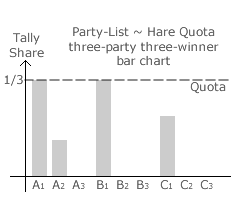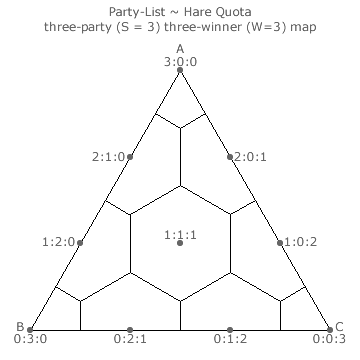Comparisons: Party-List ~ Hare Quota
Description of the Hare Quota Method
This quota method employs the largest remainder approach to seat allocation in the party-list voting system as described in the preceding party-list section. The Hare Quota is defined as the number of valid votes (V) divided by the number of seats/winners (W); namely V/W. Any candidate achieving this quota is elected and any excess above the quota is transferred to the next-ranked candidate on the party list. No more than W candidates may meet this quota. Where only X candidates meet the quota, the W - X candidates with the largest remainders are also elected. For a detailed and comprehensive outline description of the Hare Quota Party-List method, please visit the voting system section of Wikipedia or another reference source.

Hare Quota Election Example
Consider a three-party three-winner election with a Hare Quota of V/W. The tally share quota is hence 1/3 of the vote (V). Parties A, B and C respectively each receive an 11/24, 8/24 and 5/24 share of this vote. The bar chart opposite shows the resultant tally share for each candidate. Winning candidate A1 exceeds the quota and an excess of 3/24 is transferred to A2. Winner B1 also meets the quota but there is no excess. Having the largest remainder, candidate C1 also wins.
For parties A:B:C, the seat ratio is hence 1:1:1 for a tally ratio of 11:8:5. Despite party A having a tally share more than twice that of party C, this is the optimum outcome as the sum of the discrepancy magnitudes (3/24 + 0 + 3/24) is at a minimum.
Properties of the Hare Quota Party-List Method
Before comparing this method to the party-list CHPV voting system, its own properties must first be established. As with CHPV, issues regarding optimality, party cloning and disproportionality can be addressed once a variety of multiple-party multiple-winner maps have been constructed. For those advanced visitors to this website who wish to understand how such maps are constructed or who wish to construct ones that are not featured for themselves, then please refer to the Map Construction appendix for either the Two-Party Hare Quota Maps or the Three-Party Hare Quota Maps page.


Completed three-winner maps are shown in the two examples here. Notice that the domain boundaries in the above two-party map are equidistant from the seat share dots. Similarly, the regular hexagonal domain boundaries (ignoring any truncation by map edges) in the three-party map opposite are precisely centred upon the relevant seat share dots.
These two example maps are identical to those for an optimally proportional voting (OPV) system. Compare these Hare Quota maps with the OPV domains and boundaries on the CHPV maps in the Evaluations: CHVP Maps section.
Indeed, any Hare Quota Party-List map is identical to the OPV one for the corresponding S-party W-winner election. Hence, the Hare Quota maps are not repeated here since they already exist in this earlier Evaluations: CHVP Maps section as OPV maps.
- The Hare Quota Party-List method is therefore an optimally proportional voting system.
Comparison with Party-List CHPV
The optimality, party cloning and disproportionality properties of the Hare Quota Party-List method are therefore the same as those of an OPV system. As party-list CHPV is compared to the benchmark OPV system in the previous Evaluations chapter, the very same comparison applies to CHPV versus the Hare Quota method. To summarise, the optimality of the Hare Quota approach is 100% and any disproportionality in outcome is solely due to unavoidable rounding with regard to seat resolution. However, as it is especially susceptible to party cloning, the Hare Quota is nowadays largely superceded by other party-list variants that are less vulnerable to such strategic nominations.
Proceed to next section > Comparisons: Party-List ~ Droop Quota
Return to previous page > Comparisons: Party-List 3
